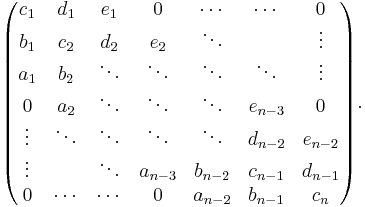Pentadiagonal matrix
In linear algebra, a pentadiagonal matrix is a matrix that is nearly diagonal; to be exact, it is a matrix in which the only nonzero entries are on the main diagonal, and the first two diagonals above and below it. So it is of the form
It follows that a pentadiagonal matrix has at most  nonzero entries, where n is the size of the matrix. Hence, pentadiagonal matrices are sparse. This makes them useful in numerical analysis.
nonzero entries, where n is the size of the matrix. Hence, pentadiagonal matrices are sparse. This makes them useful in numerical analysis.
See also
This article incorporates material from Pentadiagonal matrix on PlanetMath, which is licensed under the Creative Commons Attribution/Share-Alike License.
